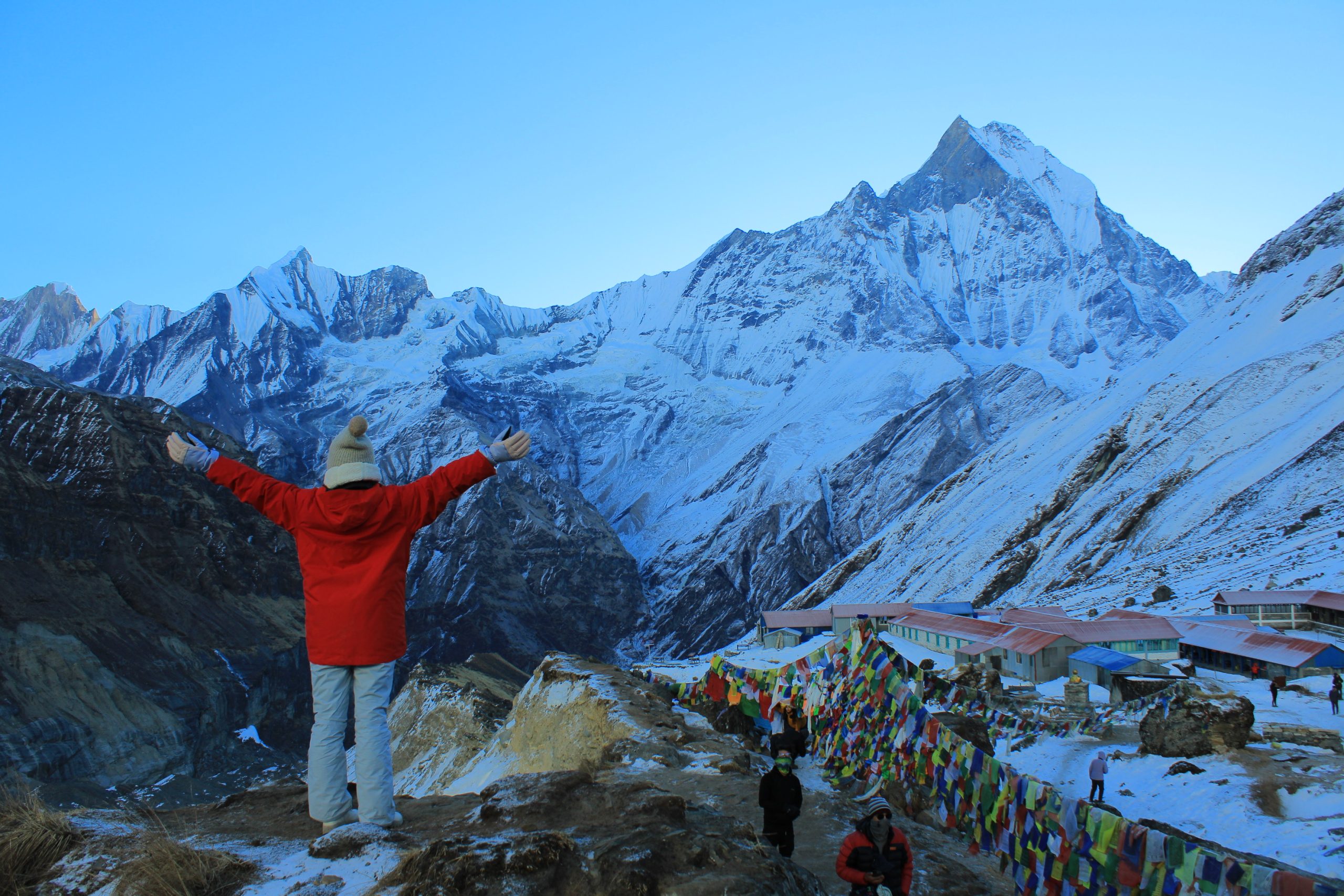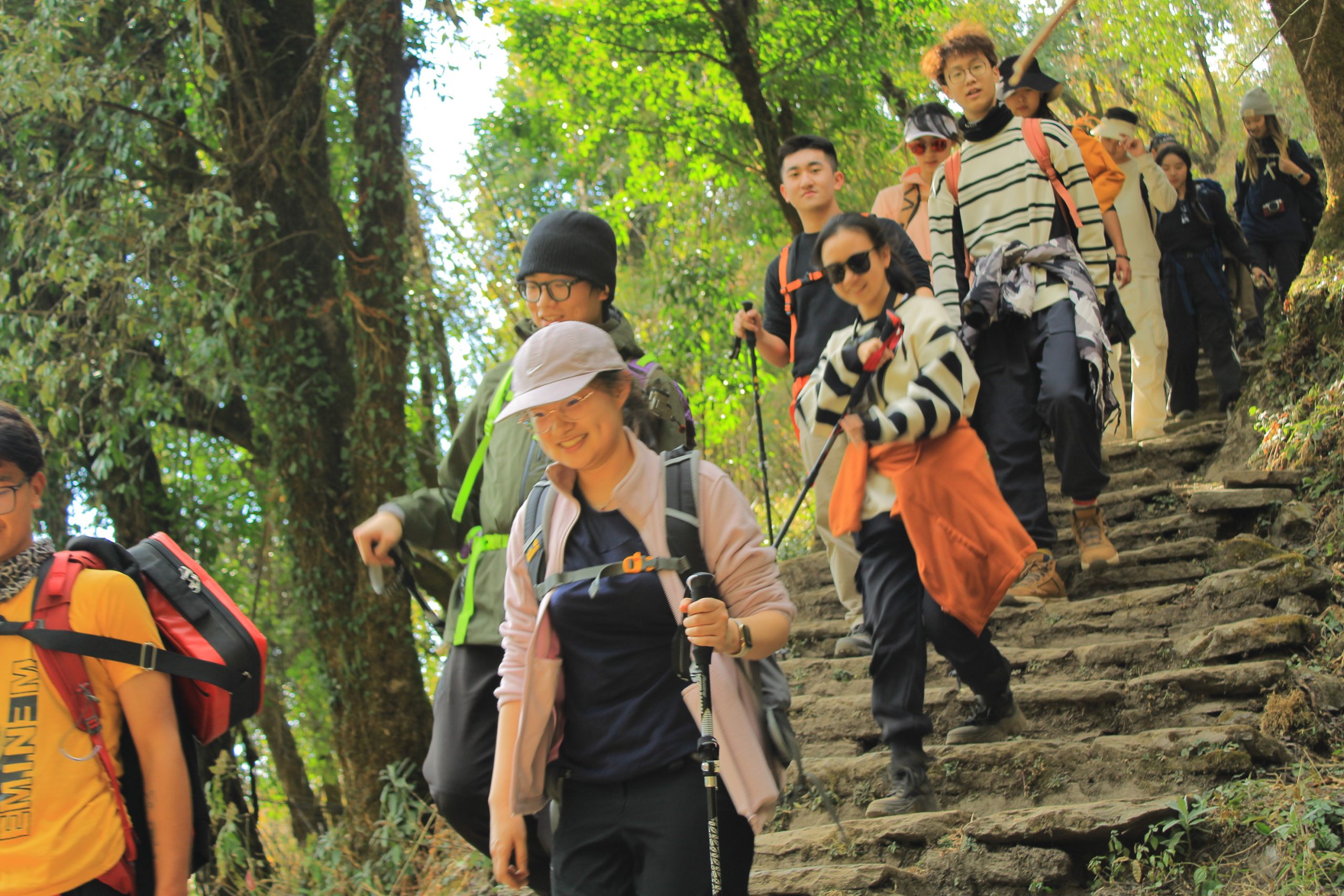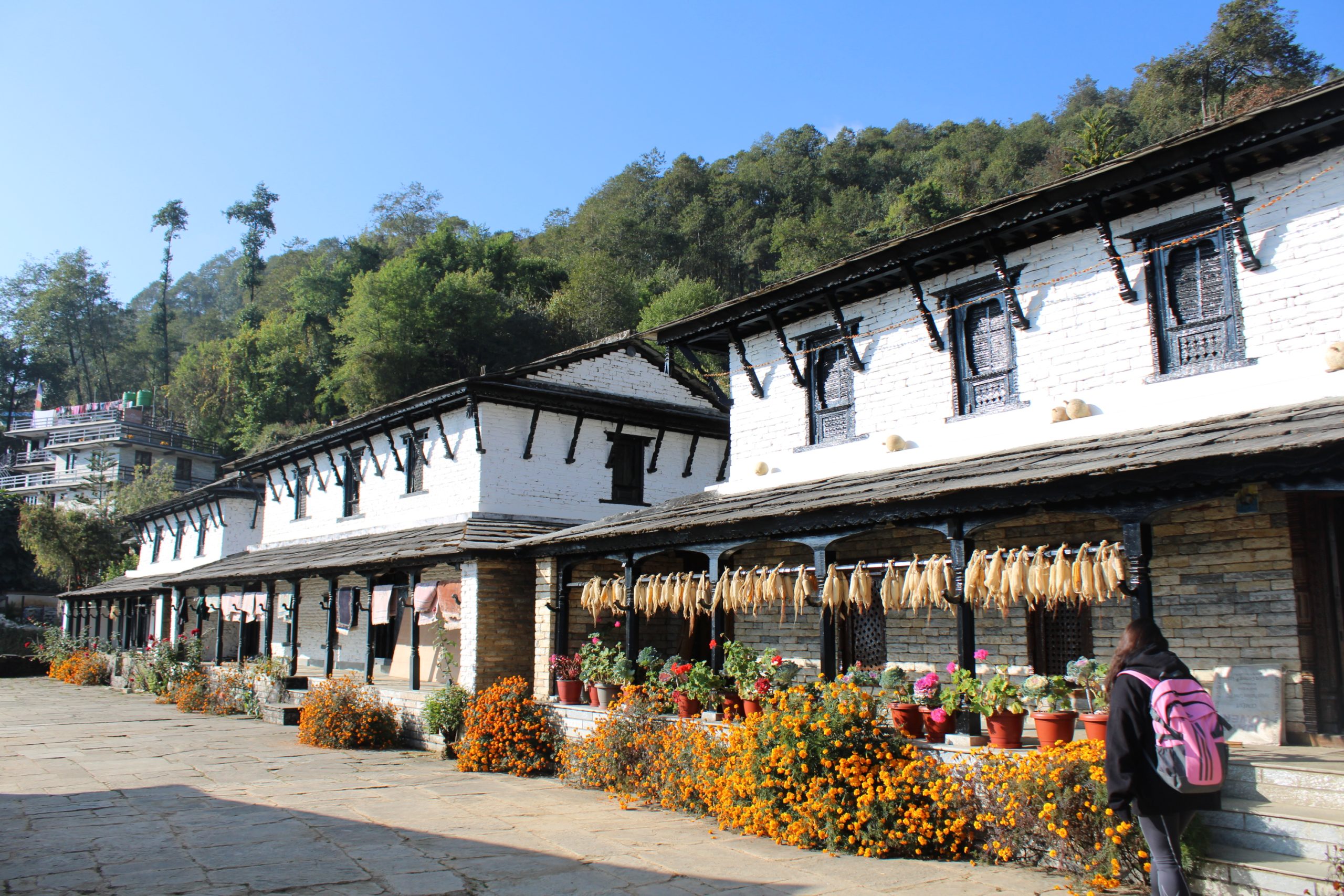Annapurna Base Camp trek is a famous trekking route in Nepal that offers breathtaking views of the Annapurna range. The trek starts from the beautiful lakeside city of Pokhara and passes through charming villages, lush forests, and terraced fields before reaching the base camp. The trail takes you along the Modi Khola river, through rhododendron forests, and over suspension bridges with stunning views of the Himalayas. Along the way, you’ll pass through various villages, including Ghandruk, which is home to the Gurung community, known for their bravery and hospitality. Reaching the base camp is a surreal experience with the massive Annapurna I towering in front of you. The view of the snow-capped mountains and glaciers is truly awe-inspiring. The trek can take anywhere from 11 to 13 days depending on the route and pace, and it’s recommended for people with a moderate level of fitness and some trekking experience. The Annapurna Base Camp trek is a must-do for anyone visiting Nepal and looking to experience the beauty of the Himalayas.
Here are some reasons why the Annapurna Base Camp trek should be on your bucket list:
Table of Contents
1. Breathtaking Mountain Scenery
The Annapurna mountain range is one of the most iconic and beautiful in the world. The trek offers unparalleled views of snow capped peaks, including Annapurna South, Annapurna I, Machhapuchhre (Fishtail), Hiunchuli, and many more. The scenery
changes dramatically as you ascend higher, and the beauty of the mountains will leave you spellbound.

2. Cultural Immersion
The trek takes you through diverse landscapes, from lush forests to alpine meadows, and from small villages to high mountain passes. Along the way, you will have the opportunity to interact with the local people and learn about their culture and way of life. The trek
passes through several Gurung and Magar villages, where you can experience their unique customs, traditions, and cuisine.
3. Challenging Yet Accessible
The Annapurna Base Camp trek is challenging but also accessible to most people with a moderate level of fitness. The trek involves several steep ascents and descents, but the pace is relatively relaxed, allowing you to acclimatize to the altitude gradually. The trek takes
around 7-12 days, depending on your itinerary and fitness level, and you can choose to do it independently or with a guide.

4. Varied Trail Experience
The trail to Annapurna Base Camp is varied and diverse, with a mix of easy and challenging sections. You will trek through beautiful rhododendron forests, cross suspension bridges over raging rivers, hike through rocky terrain, and climb steep stairs to reach the base camp. The trek also includes a visit to the famous hot springs at Jhinu
Danda, where you can relax and rejuvenate your tired muscles.
5. An Unforgettable Experience
The Annapurna Base Camp trek is an unforgettable experience that will stay with you for a lifetime. The trek offers a chance to disconnect from the hustle and bustle of daily life, to immerse yourself in nature and connect with yourself on a deeper level. The stunning scenery, the rich cultural experience, and the sense of achievement at reaching the base camp make this trek one of the most rewarding experiences you can have.
6. Ethical and Sustainable Tourism
The Annapurna Base Camp trek also offers an opportunity to practice ethical and sustainable tourism. Many trekking companies and lodges along the trail are committed to reducing their environmental impact and supporting the local community. You can choose to stay in eco-friendly lodges that use renewable energy sources, avoid plastic waste, and serve locally sourced food. Supporting such responsible tourism practices can help preserve the natural beauty of the Annapurna region and ensure that the local community benefits from tourism.
7. Flexibility in Itinerary
The Annapurna Base Camp trek also offers flexibility in terms of itinerary. You can choose to take different routes depending on your preference, fitness level, and time available. The trek can also be combined with other popular destinations in Nepal, such as the Poon Hill trek, the Ghorepani trek, or a visit to the historic city of Pokhara. You can tailor your itinerary to suit your interests and budget and create a personalized experience that suits you.
8. Affordable Adventure
Compared to other popular trekking destinations such as Everest Base Camp, the Annapurna Base Camp trek is relatively affordable. The cost of the trek depends on several factors such as the length of the trek, the level of comfort you prefer, and whether you hire a guide or not. However, even with a limited budget, you can still enjoy a fulfilling trekking experience that offers excellent value for money.
9. Safe Trekking Environment
The Annapurna Base Camp trek is also considered a safe trekking environment. The trail is well-marked, and there are several lodges and tea houses along the way that offer accommodation and food. The region is also accessible by road, and there are several rescue teams available in case of emergencies. However, it is still recommended to trek with a licensed guide who can provide support, information, and assistance in case of any unforeseen circumstances.
10. A Life-Changing Experience
The Annapurna Base Camp trek is a life-changing experience that can transform the way you see yourself and the world around you. It offers a chance to challenge yourself physically and mentally, to connect with nature, and to experience a new culture. The trek provides a sense of accomplishment and fulfillment that can boost your confidence and leave you with memories that will last a lifetime.
After making thought about trekking in Annapurna you may come across several questions regarding it. Some of the questions answers are given below and if the questions you have in your mind and you are not able to get the answer here kindly contact at the whatsapp: +977-9841120805.
Why to visit Annapurna Base Camp Trek?
1. Natural beauty: The trek takes you through some of the most beautiful landscapes in the world, including snow-capped mountains, lush forests, and cascading waterfalls. The natural beauty of the region is breathtaking and will leave you in awe.

2. Adventure: The Annapurna Base Camp trek is a challenging adventure that offers a sense of accomplishment and personal growth. It requires physical endurance and mental strength to complete, but the stunning views and sense of accomplishment are worth the effort.
3. Cultural experience: The Annapurna region is home to several ethnic communities, each with its unique culture and traditions. The trek offers an opportunity to learn about their way of life, interact with the locals, and experience their warm hospitality.
4. Wildlife: The Annapurna region is a protected area that is home to several endangered species like the snow leopard, Himalayan black bear, and musk deer. The trek offers an opportunity to spot these rare animals in their natural habitat.
5. Sunrise and sunset views: The Annapurna Base Camp trek offers some of the most spectacular sunrise and sunset views, especially from Poon Hill and Annapurna Base Camp. The sun rising or setting over the snow-capped mountains is a sight that you will never forget.
6. Accommodation and facilities: Despite being a remote trek, the Annapurna Base Camp trek offers several comfortable and affordable accommodation options along the way. You can choose from tea houses, lodges, and guest houses that provide basic amenities like clean rooms, hot showers, and Wi-Fi.
7. Local cuisine: The Annapurna region has a unique cuisine that is a blend of Nepalese, Tibetan, and Indian flavors. During the trek, you can sample some of the delicious local dishes like dal bhat (rice and lentil soup), momos (dumplings), and thukpa (noodle soup).
8. Personal growth: Trekking to Annapurna Base Camp is a challenging adventure that requires mental and physical endurance. However, it’s also a rewarding and life-changing experience that can help you grow as a person, improve your fitness.
How to Reach Annapurna Base Camp Trek?
1. By Flight: The nearest airport to the Annapurna region is in Pokhara, which is about 200 kilometers from Kathmandu. Several domestic airlines operate daily flights between Kathmandu and Pokhara, which takes about 25 minutes. From Pokhara, trekkers can take a private jeep or public transportation to the starting point of the trek.
2. By Bus: There are regular buses and mini busses that operate between Kathmandu and Pokhara, which takes about 6-8 hours depending on the road conditions. From Pokhara, trekkers can take a private jeep or public transportation to the starting point of the trek.
3. By Private Car: Trekkers can also hire a private car or jeep from Kathmandu or Pokhara to the starting point of the trek. This option is more expensive but offers more comfort and flexibility.

What are the Challenges that I would Face in Annapurna Base Camp Trek?
The Annapurna Base Camp trek is a moderate to challenging trek that involves several days of walking in the mountains, and trekkers need to be prepared for the following challenges:
1. Altitude: Annapurna Base Camp is located at an altitude of 4,130 meters (13,550 feet) above sea level, which can cause altitude sickness in some trekkers. Trekkers need to acclimatize properly to avoid altitude sickness, which can be life-threatening.
2. Physical fitness: The trek involves several days of walking in the mountains, which can be physically demanding. Trekkers need to be in good physical shape to complete the trek comfortably. It’s recommended to start training and preparing for the trek at least a
few months in advance.
3. Weather: The weather in the Himalayas can be unpredictable, and trekkers need to be prepared for all kinds of weather conditions, including rain, snow, and cold temperatures. Trekkers need to bring appropriate clothing and gear to stay warm and dry during the trek.
4. Trail conditions: The trail to Annapurna Base Camp can be steep, rocky, and uneven, and trekkers need to be prepared for challenging terrain. Trekkers need to wear appropriate footwear and be cautious while walking on the trail.
5. Accommodation and facilities: Accommodation along the trekking route is basic, with shared rooms and communal toilets. There are no luxury facilities available, and trekkers need to be prepared for basic living conditions.
6. Altitude sickness: Altitude sickness is a common challenge faced by trekkers on the Annapurna Base Camp trek. Symptoms can include headache, nausea, dizziness, and fatigue. Trekkers need to be aware of the signs of altitude sickness and take appropriate measures to prevent it, such as drinking plenty of water, acclimatizing properly, and taking medication if necessary.
7. Navigation: The Annapurna Base Camp trek involves several days of walking in the mountains, and trekkers need to be able to navigate the trail. The trail can be confusing at times, and trekkers need to be
familiar with map reading and navigation techniques.
If you’re interested to know more about this trek, visit our page on the Annapurna Base Camp Trek, which includes comprehensive details on trail routes, highlights of short Annapurna base camp trek, detailed itinerary, what to bring, recommended gear, and much more.

